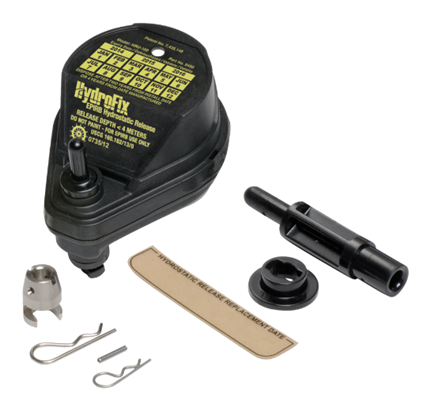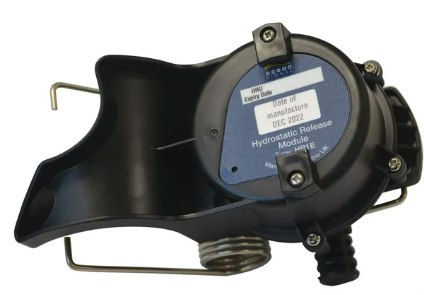Float-free EPIRBs
Float-free EPIRBs
Float-free Emergency Position Indicating Radio Beacons (FF EPIRBs) are water-activated distress beacons fitted in a float-free bracket. They are designed to activate when a vessel capsizes to a depth of 1–4 metres. They use a hydrostatic release function and a water activated switch. They float to the surface of the water and transmit a distress signal.
The guidance provided below is for general information only. You should refer to the manufacturer’s instructions for installation, activation and servicing requirements.
Float-free requirements
For float-free EPIRB carriage requirements on domestic commercial vessels see EPIRB requirements—find out what the changes mean for your DCV operation on the AMSA website.
Registration for float-free EPIRBs
All Australian EPIRBs must be registered with AMSA. Registration is valid for two years after date of issue and must be renewed before its expiry date.
Registration is free and can be completed online.
Read more about why it is important to register your beacon.
How Float-free EPIRBs work
Once a vessel capsizes 1–4 meters underwater, the following process will occur:
- The hydrostatic release function releases the EPIRB from its float-free bracket.
- Once the EPIRB is released and exposed to the water, it automatically activates via the water activated switch.
- The EPIRB floats to the surface of the water with the aerial pointing vertically and the distress signal is transmitted.
A float-free EPIRB can also be manually activated. For manual activation advice, refer to 'Activating a float-free EPIRB', 'Option 1'.
Hydrostatic Release Units
Hydrostatic Release Units (HRU) are pressure activated mechanisms designed to automatically deploy when certain conditions are met. In the marine environment this occurs when submerged underwater to a depth between 1-4 meters. The activation depth will vary depending on the model.
The pressure of the water against a diaphragm within the sealed casing causes a plastic pin to be cut, which releases the float-free bracket casing, allowing the EPIRB to float free to the water’s surface. The EPIRB must be free of obstructions to float to the surface.
Installation and maintenance of a float-free EPIRB
Mount location
Most manufacturers include detailed advice on how to install and maintain the EPIRB unit in their instruction manuals.
The effectiveness of a float-free EPIRB is dependent on where the unit is mounted.
A float-free EPIRB should be mounted:
- on the outside of the vessel. Note: the vessel may list or roll during submersion, so take this into consideration during installation
- in a clear open space away from any obstructions
- where it is easy to access in an emergency and manual activation is required
- where it is protected from damage.
Maintenance of a float-free EPIRB
Lifetime of a float-free EPIRB
There are two components of a float-free EPIRB that affect the lifetime of the beacon.
- EPIRB Battery: has a fixed lifetime and should be regularly checked to ensure it transmits properly in an emergency situation. Generally a battery will last from 5-10 years.
Read more about the options available when your battery is due to expire.
- Hydrostatic Release Unit (HRU): has a fixed lifetime and must be replaced two years from the installation date unless otherwise stated within the manufacturer’s instructions.
Dating your HRU

When you install a HRU, you must mark the expiration date correctly so you know exactly when it requires replacement.
Every HRU should have a series of stickers on it that indicate months and years. The installer must mark/peel off the month and year that the HRU is requied to be replaced in 2 years from the installation date. The same month and year should then be marked on the outside label of the float-free EPIRB enclosure bracket.
Replacing your HRU
You must replace your HRU and associated components every two years unless otherwise stated in the manufacturer's instructions. Failure to replace the HRU and release rod after two years may result in the EPIRB not deploying correctly in an emergency. Each brand of float-free EPIRB has a specific EPIRB HRU model and replacement kit approved for installation, refer to the manufacturer instructions. A liferaft HRU or reusable HRU are not approved to be installed in a float free EPIRB. Once a float-free EPIRB has been activated, the release rod is cut in half in order to release the EPIRB to float free. It is important to ensure you replace the HRU and release rods after it has been used.
 |
 |
 |
Activating a float-free EPIRB
A float-free EPIRB has both a water activated switch and a manual activation switch, resulting in two options for activation:
- Option 1: Manual activation – Manually remove the float-free bracket lid then remove the EPIRB. Activate the EPIRB by pressing the ON switch or by placing it in water.
- Option 2: Water activation – This will happen automatically when the vessel capsizes. See How Float-free EPIRBs work.
Once an EPIRB has been activated, it must be returned to the manufacturer for servicing. This will ensure the EPIRB is fit for purpose for the next journey. Read more about servicing requirements below.
Important notes:
- You cannot fit a manual EPIRB in a float free bracket.
- You must ensure the EPIRB and bracket are the same brand to ensure it operates correctly.
- Refer to the manufacturer’s instructions for activation details of particular models.
Float-free EPIRBs in shallow waters
The hydrostatic release unit will activate when 1–4 metres underwater. A float-free EPIRB does not have to be submerged—it can also be manually removed from its bracket and manually activated.
Detection of a float-free EPIRB
The Cospas-Sarsat satellite system is used to detect float-free EPIRBs in the same way all distress beacons are detected.
Read more about how distress beacons are detected.
Buying or converting a Float-free EPIRB
Please note manually activated EPIRBs cannot be converted to a Float Free EPIRB, such models include: GME MT400, GME MT406, GME MT600, KTI SA1, KTI SA1G, KTI SA3G, Ocean Signal rescueMe EPIRB1 and McMurdo A5.
Buying a float-free EPIRB
Cost
The cost of a float-free EPIRB will depend on the model. For instance, a float-free EPIRB without GPS can be purchased for approximately $700 AUD. GPS models cost approximately $100 more.
Float-free EPIRBs with GPS capability
Although it will not be mandated by law, AMSA recommends the use of EPIRBs fitted with GPS as they provide the quickest and most accurate alerts. Read more on why GPS is best.
Programming
When you buy a float-free EPIRB, you will be asked how you wish to program it. There are three options:
- Option 1 – Manufacturers serial number
- Option 2 – Maritime Mobile Service Identity (MMSI) of vessel
- Option 3 – Radio callsign of vessel (registered with Australian Communications and Media Authority
Option 1 is most often recommended as it is the most flexible programming method and enables a faster purchase process. It also allows the EPIRB to be repositioned onto another vessel without reprogramming—just remember to update the EPIRB registration.
Option 2 and 3 are the most common methods of programming for SOLAS flagged vessels. MMSI and Radio callsign programming is customised coding and may delay the purchase and delivery process.
Option 3 is the MMSI or Radio callsign program. If you use this, all EPIRBs on board using this program should be programmed with the same identification so you should advise the supplier/retailer if you have other EPIRBs on board.
The EPIRB HEX ID will be unique for each beacon as they can specify the unit number (eg 0, 1, 2) in the coding.
If the EPIRB is programmed using this method the EPIRB cannot be repositioned on another vessel unless it is reprogrammed with the new vessel’s MMSI or Radio callsign.
Purchasing float free EPIRBs from overseas—Warning
Australian Domestic Commercial Vessels complying with EPIRB carriage requirements must have an Australian coded and registered EPIRB with AMSA onboard. If an EPIRB is purchased overseas it may not be compliant with the AS/NZS 4280.1 and may be incorrectly programmed with another country code which will prevent Australian registration and therefore will be non-compliant. In order to register a compliant Australian EPIRB with AMSA the EPIRB must be programmed with the Australian country code ‘503’ and the HEX ID will commence with ‘BE’ or ‘3E’.
EPIRB brands
AMSA does not endorse any particular brand of float-free EPIRB; however, we have published a list of EPIRB manufacturers currently in Australia.
Before you purchase, read about the operating capabilities of float-free EPIRB on the manufacturers' websites.
Converting existing EPIRBs to float-free
Only EPIRBs with a water-activation switch (Class 2 EPIRBs) can be converted to a float-free EPIRB by purchasing a float-free bracket and hydrostatic release unit (HRU). Make sure the float-free bracket and HRU are from the same manufacturer as the EPIRB unit, to ensure it operates correctly.
Before converting your EPIRB, consider the following:
- Battery expiry date. If your EPIRB is close to expiring, it may be more cost effective to replace it instead.
- Costs for re-programming your existing EPIRB. This is a very important step in converting your EPIRB to float-free.
Contact your manufacturer to determine whether your existing EPIRB can be used in a float-free bracket.
Reprogramming
When converting your existing EPIRB into a float-free EPIRB, you must have it reprogrammed to ensure it will work correctly in an emergency situation.
Float-free EPIRBs in other countries
From 1 January 2019, New Zealand will mandate the carriage of float-free EPIRBs on all fishing vessels between 7.5 metres and 24 metres operating outside enclosed waters (harbours, estuaries and other inland or sheltered waters). See Maritime New Zealand for more information.
In Ireland, the Code of Practice for small fishing vessels was revised in 2015. It requires automatic, float-free EPIRBs to be carried onboard some kinds of fishing vessels, and for each person onboard to wear a Personal Locator Beacon (PLB). See the Department of Transport, Tourism and Sport website
Other ways to improve safety standards on board your vessels
Float-free EPIRBs are just one of the crucial pieces of equipment that enhance safety at sea. AMSA is working on a number of other regulatory measures to improve safety standards for Domestic Commercial Vessels (DCVs). These involve safety equipment such as lifeboats, lifejackets and other potentially lifesaving equipment.
(See NSCV Part C7A, Part F1 and Part F2).
Additional EPIRBs for quick access in the wheelhouse
It is not mandatory to carry extra EPIRBs, however, you may choose to carry an EPIRB or Personal Locator Beacon (PLB) on your body as an additional safety measure.
EPIRBs in inflatable coastal life raft
Inflatable life rafts do not need float-free EPIRBs.
AMSA has made a minor change to NSCV Part C7A to clarify that the kind of EPIRB to be carried in inflatable coastal life rafts is a manual activated EPIRB (Class 3).
Use of manually activated EPIRB or PLB
EPIRBs that cannot float free have inherent limitations in circumstances such as a capsized vessel. AMSA is of the view that with suitable education and the development of a robust safety culture, float-free EPIRBs will be recognised as the most effective location signalling device in an emergency.
AMSA also considered mandating the carriage and use of Personal Locator Beacons (PLBs) instead of float-free EPIRBs. The safety benefits of PLBs rely on individuals remembering to wear it (either on their lifejacket or on a lanyard). Additionally, the costs associated with each individual having a PLB will, in most cases, significantly exceed the cost of one float-free EPIRB being carried on the vessel.




Main menu